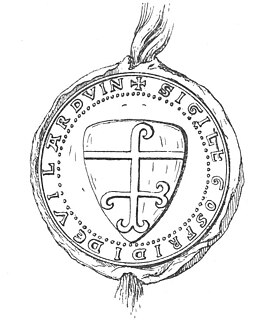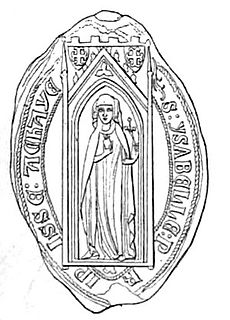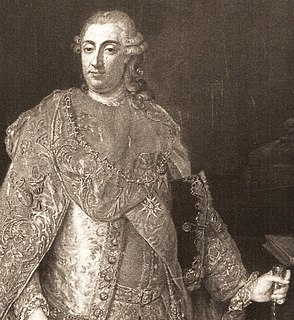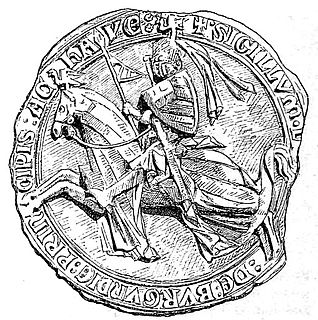 W
WDon Carlo Capece Galeota was an Italian nobleman, holding the titles of Duke of Regina and Duke of Sant'Angelo a Fasanella from the death of his father Francesco Capece Galeota in 1838 to his own death in 1908. From 1889 onwards, Carlo was also recognized as the heir to the extinct Tocco family, as he was a matrilineal descendant of the family, assuming their titles of Prince of Montemiletto and titular Prince of Achaea, among others.
 W
WDon Carlo III di Tocco Cantelmo Stuart, or Carlo di Tocco for short, was a 19th-century Italian noble, serving as the Prince of Montemiletto and the titular Prince of Achaea from the death of his father Francesco di Tocco Cantelmo Stuart in 1877 to his own death in 1884. Carlo III di Tocco Cantelmo Stuart was the last living member of the Tocco family, which had once ruled the Despotate of Epirus. Carlo was prominent among the nobility of Italy, having held high honors in the Kingdom of the Two Sicilies until its fall in 1861 and thereafter becoming a leader figure among those who sought to restore it.
 W
WCenturione II Zaccaria, scion of a powerful Genoese merchant family established in the Morea, was installed as Prince of Achaea by Ladislaus of Naples in 1404 and was the last ruler of the Latin Empire not under Byzantine suzerainty.
 W
WCharles I, commonly called Charles of Anjou, was a member of the royal Capetian dynasty and the founder of the second House of Anjou. He was Count of Provence (1246–85) and Forcalquier in the Holy Roman Empire, Count of Anjou and Maine (1246–85) in France; he was also King of Sicily (1266–85) and Prince of Achaea (1278–85). In 1272, he was proclaimed King of Albania; and in 1277 he purchased a claim to the Kingdom of Jerusalem.
 W
WCharles II, also known as Charles the Lame, was King of Naples, Count of Provence and Forcalquier (1285–1309), Prince of Achaea (1285–1289), and Count of Anjou and Maine (1285–1290); he also styled himself King of Albania and claimed the Kingdom of Jerusalem from 1285. He was the son of Charles I of Anjou—one of the most powerful European monarchs in the second half of the 13th century—and Beatrice of Provence. His father granted Charles the Principality of Salerno in the Kingdom of Sicily in 1272 and made him regent in Provence and Forcalquier in 1279.
 W
WCharles the Short or Charles of Durazzo was King of Naples and the titular King of Jerusalem from 1382 to 1386 as Charles II, and King of Hungary from 1385 to 1386 as Charles II. In 1381, Charles created the chivalric Order of the Ship. In 1383, he succeeded to the Principality of Achaea on the death of James of Baux.
 W
WFerdinand of Majorca was an infante of the Kingdom of Majorca; he was born at Perpignan, the third son of King James II. He was Viscount of Aumelas and Lord of Frontignan from 1311 and claimed the title of Prince of Achaea from 1315.
 W
WFlorent of Hainaut was Prince of Achaea from 1289 to his death, in right of his wife, Isabella of Villehardouin. He was the son of John I of Avesnes and Adelaide of Holland. From his father he received the stadholdership (government) of Zeeland.
 W
WGeoffrey I of Villehardouin was a French knight from the County of Champagne who joined the Fourth Crusade. He participated in the conquest of the Peloponnese and became the second prince of Achaea.
 W
WGeoffrey II of Villehardouin was the third prince of Achaea. From his accession to the princely throne, he was a powerful and respected person, and even from French knights came to the principality to enter his service. Geoffrey II emerged as the most powerful vassal of the Latin Empire of Constantinople, the person around whom the crusaders' states in modern Greece gradually regrouped themselves. He came to the rescue of the imperial capital three times. As a reward of his services to the Latin Empire, he was granted suzerainty over the island of Euboea by his brother-in-law, Emperor Baldwin II of Constantinople (1228–1261). He was also a humane prince, benevolent and just, solicitous for the condition of the common people.
 W
WIsabella of Villehardouin was princess of Achaea from 1289 to 1307. She was the elder daughter of Prince William II of Achaea and of his third wife, Anna Komnene Doukaina, the second daughter of Michael II Komnenos Doukas, the despot of Epiros.
James III, known as James the Rash, was King of Majorca from 1324 to 1344. He was the son of Ferdinand of Majorca and Isabella of Sabran.
 W
WJoanna I, also known as Johanna I, was Queen of Naples, and Countess of Provence and Forcalquier from 1343 to 1382; she was also Princess of Achaea from 1373 to 1381.
 W
WJohn of Gravina, also known as John of Anjou, was Count of Gravina 1315–1336, Prince of Achaea 1318-1332, Duke of Durazzo 1332–1336 and ruler of the Kingdom of Albania. He was the youngest son of King Charles II of Naples and Mary of Hungary.
 W
WDon Leonardo VII Tocco, later also known under the full name Leonardo di Tocco Cantelmo Stuart, was an 18th-century Italian noble, serving as the Prince of Montemiletto and the titular Prince of Achaea from the death of his father Carlo Antonio Tocco in 1701 to his own death in 1776.
 W
WLouis of Burgundy was a member of the Capetian House of Burgundy who ruled the Principality of Achaea and claimed the defunct Kingdom of Thessalonica.
 W
WMaria II Zaccaria was a Princess of Achaia.
 W
WMatilda of Hainaut was the Princess of Achaea from 1313 to 1318. She was the daughter of Isabella of Villehardouin and her husband Florent of Hainaut.
 W
WOdo IV or Eudes IV was Duke of Burgundy from 1315 until his death and Count of Burgundy and Artois between 1330 and 1347, as well as titular King of Thessalonica from 1316 to 1320. He was the second son of Duke Robert II and Agnes of France.
 W
WPedro de San Superano was one of the captains of the Navarrese Company in the Morea from 1379 until he was made Prince of Achaea in 1396, a post he held to his death.
 W
WPhilip I, known as Philip of Savoy was the lord of Piedmont from 1282 until his death and prince of Achaea between 1301 and 1307. He was the son of Thomas III of Piedmont and Guyonne de Châlon.
 W
WPhilip II of the Angevin house, was Prince of Achaea and Taranto, and titular Latin Emperor of Constantinople from 1364 to his death in 1373.
 W
WPhilip I of Taranto, of the Angevin house, was titular Latin Emperor of Constantinople by right of his wife Catherine of Valois–Courtenay, Despot of Romania, King of Albania, Prince of Achaea and Taranto.
 W
WDon Restaino Gioacchino di Tocco Cantelmo Stuart, or Restaino di Tocco for short, was an 18th-century Italian noble, serving as the Prince of Montemiletto and the titular Prince of Achaea, among other titles, from the death of his father Leonardo VII Tocco in 1776 to his own death in 1796.
 W
WRobert II of Taranto, of the Angevin family, Prince of Taranto (1331–1346), King of Albania (1331–1364), Prince of Achaea (1332–1346), and titular Latin Emperor (1343/1346-1364).
 W
WWilliam I of Champlitte (1160s-1209) was a French knight who joined the Fourth Crusade and became the first prince of Achaea (1205–1209).
 W
WWilliam of Villehardouin was the fourth prince of Achaea in Frankish Greece from 1246 to 1278. The younger son of Prince Geoffrey I, he held the Barony of Kalamata in fief during the reign of his elder brother Geoffrey II. William started to rule Achaea as regent for his brother during Geoffrey's military campaigns against the Greeks of Nicaea who were the principal enemies of his overlord, the Latin Emperor of Constantinople Baldwin II. William succeeded his childless brother in the summer of 1246. Conflicts between Nicaea and Epirus enabled him to complete the conquest of the Morea in about three years. He captured Monemvasia and built three new fortresses, forcing two previously autonomous tribes, the Tzakones and Melingoi into submission. He participated in the unsuccessful Egyptian crusade of Louis IX of France who rewarded him with the right to issue currency in the style of French royal coins.